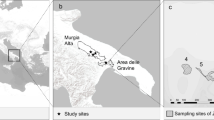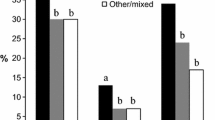Abstract
Landscapes are composed of a multitude of habitat types which, potentially, can influence natural enemy populations. The contribution of specific habitat types to sustaining natural enemy populations in agricultural landscapes and the associated ecosystem service of pest control is not well understood. We investigated how landscape composition affected parasitism rates in 22 organic Brussels sprout fields in The Netherlands. Second and third instar larvae of Plutella xylostella were placed on experimental Brussels sprout plants in Brussels sprout fields and were recovered after two days in the field. Parasitism rates ranged between 4 and 94% and were related to landscape variables at a scale of 0.3, 1, 2 and 10 km. Univariate analysis using a generalized linear mixed model indicated that parasitism rates were positively related with area of forests at a scale of 1, 2 and 10 km, forest edges at a scale of 1 and 2 km and road verges at a scale of 1 km. Forest and road verges are likely to provide food and alternative hosts for parasitoids and are less disturbed habitats than agricultural fields. These results suggest that forests and road verges may play an important role in sustaining effective densities of parasitoids of P. xylostella in agricultural landscapes.



Similar content being viewed by others
References
Baggen LR, Gurr GM (1998) The influence of food on Copidosoma koehleri (Hymenoptera: Encyrtidae), and the use of flowering plants as a habitat management tool to enhance biological control of potato moth, Phthorimaea operculella (Lepidoptera: Gelechiidae). Biol Control 11:9–17
Bianchi FJJA, Booij CJH, Tscharntke T (2006) Sustainable pest regulation in agricultural landscapes: a review on landscape composition, biodiversity and natural pest control. Proc R Soc B Biol Sci 273:1715–1727
Breslow NE, Clayton DG (1993) Approximate inference in generalized linear mixed models. J Am Stat Assoc 88:9–25
Bukovinszky T, Trefas H, van Lenteren JC, Vet LEM, Fremont J (2004) Plant competition in pest-suppressive intercropping systems complicates evaluation of herbivore responses. Agric Ecosyst Environ 102:185–196
Costamagna AC, Landis DA (2004) Effect of food resources on adult Glyptapanteles militaris and Meteorus communis (Hymenoptera: Braconidae), parasitoids of Pseudaletia unipuncta (Lepidoptera: Noctuidae). Environ Entomol 33:128–137
Costamagna AC, Menalled FD, Landis DA (2004) Host density influences parasitism of the armyworm Pseudaletia unipuncta in agricultural landscapes. Basic Appl Ecol 5:347–355
Costanza R, d’Arge R, de Groot R, Farber S, Grasso M, Hannon B, Limburg K, Naeem S, O’Neill RV, Paruelo J, Raskin RG, Sutton P, van den Belt M (1997) The value of the world’s ecosystem services and natural capital. Nature 387:253–260
DeBach P, Rosen D (1991) Biological control by natural enemies, 2nd edn. Cambridge University Press, Cambridge, 440 pp
De Wit AJW, Clevers JGPW (2004) Efficiency and accuracy of per-field classification for operational crop mapping. Int J Remote Sens 25:4091–4112
Duelli P, Obrist MK (2003) Regional biodiversity in an agricultural landscape: the contribution of seminatural habitat islands. Basic Appl Ecol 4:129–138
Dunning JB, Danielson BJ, Pulliam HR (1992) Ecological processes that affect populations in complex landscapes. Oikos 65:169–175
Dyer LE, Landis DA (1996) Effects of habitat, temperature, and sugar availability on longevity of Eriborus terebrans (Hymenoptera: Ichneumonidae). Environ Entomol 25:1192–1201
Dyer LE, Landis DA (1997) Influence of noncrop habitats on the distribution of Eriborus terebrans (Hymenoptera: Ichneumonidae) in cornfields. Environ Entomol 26:924–932
Elliott NC, Kieckhefer RW, Lee JH, French BW (1998) Influence of within-field and landscape factors on aphid predator populations in wheat. Landsc Ecol 14:239–252
Elliott NC, Kieckhefer RW, Beck DA (2002) Effect of aphids and the surrounding landscape on the abundance of Coccinellidae in cornfields. Biol Control 24:214–220
Fraser SEM, Dytham C, Mayhew PJ (2007) Determinants of parasitoid abundance and diversity in woodland habitats. J Appl Ecol 44:352–361
GenStat Committee (2007) GenStat Release 10 reference manual – part 1: summary. VSN International
Landis DA, Wratten SD, Gurr GM (2000) Habitat management to conserve natural enemies of arthropod pests in agriculture. Annu Rev Entomol 45:175–201
Maier CT (1981) Parasitoids emerging from puparia of Rhagoletis pomonella (Diptera, tephritidae) infesting hawthorn and apple in Connecticut USA. Can Entomol 113:867–870
Marino PC, Landis DA (1996) Effect of landscape structure on parasitoid diversity and parasitism in agroecosystems. Ecol Appl 6:276–284
Menalled FD, Costamagna AC, Marino PC, Landis DA (2003) Temporal variation in the response of parasitoids to agricultural landscape structure. Agric Ecosyst Environ 96:29–35
Naylor RL, Ehrlich PR (1997) Natural pest control services and agriculture. In: Daily GC (ed) Nature’s services: societal dependence on natural ecosystems. Island Press, Washington, pp 151–174
Rand TA, Tylianakis JM, Tscharntke T (2006) Spillover edge effects: the dispersal of agriculturally subsidized insect natural enemies into adjacent natural habitats. Ecol Lett 9:603–614
Roland J, Taylor PD (1997) Insect parasitoid species respond to forest structure at different spatial scales. Nature 386:710–713
Roschewitz I, Hücker M, Tscharntke T, Thies C (2005) The influence of landscape context and farming practices on parasitism of cereal aphids. Agric Ecosyst Environ 108:218–227
Schellhorn NA, Silberbauer L (2002) The role of surrounding vegetation and refuges: increasing the effectiveness of predators and parasitoids in cotton and broccoli systems. Proceedings for the 1st international symposium on biological control of arthropods, Honolulu, Hawaii, USA, pp 235–243
Schmidt MH, Lauer A, Purtauf T, Thies C, Schaefer M, Tscharntke T (2003) Relative importance of predators and parasitoids for cereal aphid control. Proc R Soc Lond Ser B 270:1905–1909
Talekar NS, Shelton AM (1993) Biology, ecology, and management of the Diamondback moth. Annu Rev Entomol 38:275–301
Thies C, Tscharntke T (1999) Landscape structure and biological control in agroecosystems. Science 285:893–895
Thies C, Steffan-Dewenter I, Tscharntke T (2003) Effects of landscape context on herbivory and parasitism at different spatial scales. Oikos 101:18–25
Thies C, Roschewitz I, Tscharntke T (2005) The landscape context of cereal aphid-parasitoid interactions. Proc R Soc Lond Ser B 285:893–895
Tscharntke T, Brandl R (2004) Plant-insect interactions in fragmented landscapes. Annu Rev Entomol 49:405–430
Tscharntke T, Rand TA, Bianchi FJJA (2005) The landscape context of trophic interactions: insect spillover across the crop-noncrop interface. Ann Zool Fenn 42:421–432
Tumlinson JH, Turlings TCJ, Lewis WJ (1992) The semiochemical complexes that mediate insect parasitoid foraging. Agric Zool Rev 5:221–252
Wagner HH, Edwards PJ (2001) Quantifying habitat specificity to assess the contribution of a patch to species richness at a landscape scale. Landsc Ecol 16:121–131
Wang XG, Keller MA (2005) Patch time allocation by the parasitoid Diadegma semiclausum (Hymenoptera : Ichneumonidae). II. Effects of host density and distribution. J Insect Behav 18:171–186
Winkler K, Wäckers F, Bukovinszkine Kiss G, van Lenteren J (2006) Sugar resources are vital for Diadegma semiclausum fecundity under field conditions. Basic Appl Ecol 7:133–140
Wu JG, Hobbs R (2002) Key issues and research priorities in landscape ecology: an idiosyncratic synthesis. Landsc Ecol 17: 355–365
Acknowledgements
This research was financially supported by the DWK Program 432 of the Dutch Ministry of Agriculture, Nature Management and Food Quality. We thank R.J.M. van Kats, A.J. Griffioen, W.J. Dimmers, M. van der Veen and W.K.R.E. van Wingerden for conducting field work and assessment of parasitism, F. Müller for processing data and H.A.M. Meeuwsen for GIS analysis (all Alterra Green World Research). Further, we thank K. Winkler and A. Dulos (Netherlands Institute of Ecology, NIOO-KNAW) for instructions on the dissection of P. xylostella and G.J.Z. Gols and T. Bukovinszky (Laboratory of Entomology, Wageningen University) for helpful discussion. Finally, we thank L. Koopman (Laboratory of Entomology, Wageningen University) for provision of P. xylostella populations and the farmers for their hospitality.
Author information
Authors and Affiliations
Corresponding author
Rights and permissions
About this article
Cite this article
Bianchi, F.J.J.A., Goedhart, P.W. & Baveco, J.M. Enhanced pest control in cabbage crops near forest in The Netherlands. Landscape Ecol 23, 595–602 (2008). https://doi.org/10.1007/s10980-008-9219-6
Received:
Accepted:
Published:
Issue Date:
DOI: https://doi.org/10.1007/s10980-008-9219-6




